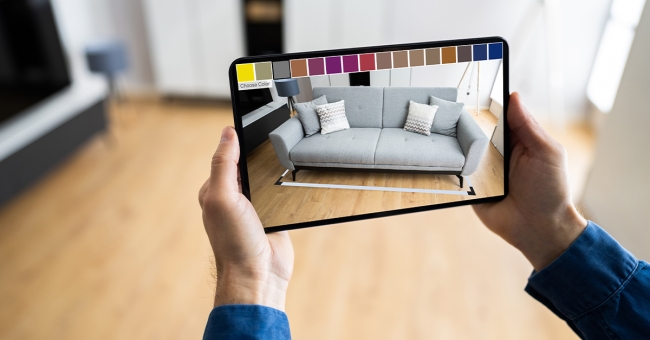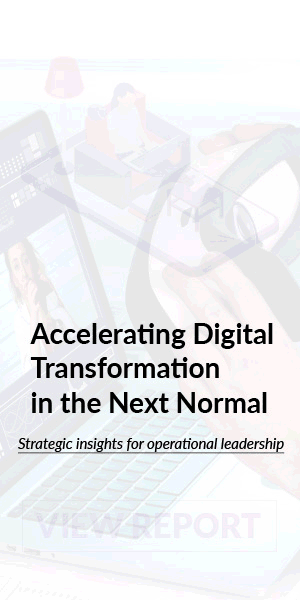Topics
How Mixed Reality is Reshaping the Customer Experience

Over the past few decades, we’ve witnessed just how dramatically technology can change the customer experience. From the advent of the internet bringing eCommerce to the mainstream to AI-powered recommendation engines that drive sales by streamlining the shopping process, businesses that stay ahead of the curve with these trends reap the rewards.
The same move is happening right now with immersive technologies, such as augmented reality (AR). The driving force behind this is the simple fact that AR compensates for the biggest shortcoming of online shopping and customer service: being able to see/try on/become familiar with a new object right in front of you, with your own eyes.
That’s why, when we interviewed over 100 operational leaders from today’s top enterprises, we found that more than 77 percent planned to increase their spending on AR, with 90 percent agreeing or strongly agreeing that AR will help their organizations gain a strategic/competitive advantage.
Here’s how those leaders are planning on putting those dollars to work and reshape the customer experience.
AR for Sales and Marketing
Simply put, AR shopping is emerging as the next big trend in how customers interact with their favorite brands. Being able to use your smartphone to visualize how a piece of furniture will fit into your home, how a new article of clothing will look on you, or unbox an appliance, test it out, request support and see how it will look in your space inspires us as consumers with a new confidence to press the purchase button.
Our own research also supports this claim, as 29 percent of enterprise survey respondents cite sales support demos as a top application for AR and mixed reality (MR) this year.
Examples of these experiences range from IKEA’s AR furniture app, fashion brands like Converse, Zara, and Adidas enabling virtual try-on, and food preview applications, such as those from Bareburger, KABAQ and ChopChop. Especially as customers become increasingly skeptical of the authenticity of online reviews consumers are looking for new ways to research goods before making a purchase.
The fun doesn’t stop there, however. Innovative companies are also using AR to enhance customer education by creating new experiences with their packaging. Think of it as the next evolution of cereal box games. For example, winemaker 19 Crimes released a companion app that their consumers can use to bring the characters on the bottle’s label to life and learn more about the history of the “19 crimes” that would send a British prisoner to Australia.
Another example comes from Bud Light’s partnership with Washington’s NHL team, the Capitals. Their “Tilt the Ice” campaign included using special Bud Light coasters to play a 3D interactive game in combination with a smartphone app. There’s also the interesting case of Dominos Japan offering its customers the ability to point their phone at their pizza box to enjoy a concert by virtual pop star Hatsune Miku.
Companies are amping up customer experiences and education for good reason. According to research by Conductor, consumers are 131 percent more likely to buy from a brand immediately after they consume early-stage, educational content.
AR for Customer Service and Post-Sale Support
The use cases for AR go well beyond sales and marketing. Top companies are using AR for service and support to inspire brand loyalty, boost KPIs like net-promoter score and reduce travel time while simultaneously increasing the productivity of their customer service and technical support agents.
Whether that takes the form of using an AR overlay “user’s manual” to troubleshoot, fix a broken machine or connect customers with remote experts who can use AR applications to both see the problem and offer visual guidance, immersive technology represents a major paradigm shift in post-sale support. That’s why 53.5 percent of survey respondents say that use of remote or guided repair, service, and maintenance tech is the new normal, while 55.5 percent say the same about enabling customers with remote diagnoses and/or self-serve tools. According to NRF, last year alone, retailers saw over $761 billion of merchandise returned to stores and warehouses. Another significant benefit of mixed reality in shopping is the ability to try before you buy to increase consumer confidence.
Said Doug Stephen, president, Enterprise Learning and TeamworkAR™, CGS, “From phlebotomists and fast-food workers to field services professionals and retail salespeople, we’re empowering frontline workers [and consumers] with the right information and training at the right time, when and where it’s needed. Our partnership with companies, such as Meta and the Oculus [Quest for Business] program, is an exciting step toward realizing our shared vision of bringing experiential learning and augmented reality to enterprises.”
Along similar lines, when we asked the question “What is your expectation for how the following factors will trend in 2022?”, we heard the following:
- 58 percent say the use of remote guided repair, service, and maintenance tech will increase, while 37 percent say it will stay the same.
- 53 percent expect an increase in enabling customers with remote diagnoses and/or self-service tools, while 43 percent expect it to stay the same.
- 34 percent cite faster service response times, and 55 percent say it will stay the same.
- 31 percent point to increased first time fix rates, with 64 percent saying it will stay the same.
When we followed up by asking the top three ways that they plan to apply AR/MR, 44.7 percent say that remote diagnostics is a top use case. Similarly, 31.5 percent point to self-service customer support, while 21 percent cite repairs and maintenance.
Narrowing in on tech support specifically, some 56 percent say that first time fix rates are the biggest benefit to AR. Reduced cost of service and reduced training time in learning programs tied for second with at 50 percent each.
That’s why 42 percent of respondents say that their organization has incorporated AR into tech support within the last year, while another 46 percent plan to within the next 12 months.
The Power of Seeing It
What makes AR such a powerful tool for enhancing customer experience? The answer lies in its ability to bridge the gap that we experienced in the previous generation of digital technology. AR returns us to a place where we can see what we’re interested in investing in before we buy it and make support, maintenance and repair a face-to-face experience again, virtually.
Discover the power for yourself by integrating AR into your strategy for enhancing customer experience. Find out more by downloading your own free copy of the Operational Leaders 2022 Annual Tech Trends Report.

